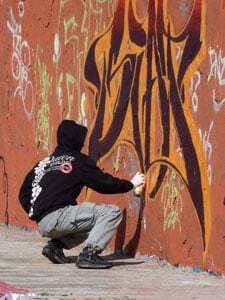 Graffiti continues to pose a substantial cost to local and state governments, nationally. Time and again, community members wake to find an expanse of pristine wall across the road from their homes or businesses, “tagged” with the latest spray painted graphics of street artists who use public and private wall spaces, roads and street surfaces as their canvases. It is an ongoing problem and an ongoing concern and costs the taxpayer millions of dollars each year.
Graffiti continues to pose a substantial cost to local and state governments, nationally. Time and again, community members wake to find an expanse of pristine wall across the road from their homes or businesses, “tagged” with the latest spray painted graphics of street artists who use public and private wall spaces, roads and street surfaces as their canvases. It is an ongoing problem and an ongoing concern and costs the taxpayer millions of dollars each year.
In an effort to curb the problem, South Australian Police have proposed a new approach, stating that offenders should be made to pay compensation.
At the moment, the laws governing graffiti in South Australia are under review and up for consideration are ideas in relation to effective punitive measures that actually deter graffiti artists from tagging. South Australian Police Commissioner Mal Hyde believe “a HECS style scheme where offenders are made to pay compensation for the damage their graffiti causes, once their income is high enough,”[1] may be the way to approach it.
Director of the South Australian Youth affairs Council, Anne Bainbridge disagrees and says restorative justice s a more effective method of dealing with youth graffiti. “This entails young people who have committed graffiti vandalism being involved in cleaning the vandalism or restoring the vandalism, and also engaging with the broader community about the effect that behavior has on the community.”[2]
The problem is so significant Australia wide, that the New South Wales government has even issued a detailed publication on graffiti for use by local government, planners and designers. Titled the “NSW Graffiti Solutions Handbook,” it outlines the cost to the community, its sub-cultural value to youth as a component of contemporary pop culture, as well as various means and ways of addressing the management of graffiti and its removal, across the state. Part of the approach entails educating youth on the development of legal pieces in designated local government areas or areas where youths might congregate such as youth centres, skate parks and recreational parks.[3]
Envirosafe Solutions has developed a highly effective and specialized graffiti cleaner that can remove tags and obtrusive and unwanted graffiti art from most surfaces. Extreme Green Graffiti Remover is an environmentally friendly alternative to older style graffiti removers that contained harsh, toxic acids that were unsafe and difficult to use.
It can remove liquid paper, crayon, whiteboard marker, permanent texta markings, ink and spray paint. And it can be applied to a variety of surfaces such as glass, brick wood, concrete, metals, masonry surfaces and plastic. It is suitable for use on just about any surface that has been vandalized by tagging and graffiti art.
If you require an eco-friendly graffiti remover for your surfaces, call Envirosafe Solutions on 1300 88 90 70
[1] Haxton, N.Payback Proposed to punish graffiti vandals. http://abc.net.au/news/stories/2011/05/113213566.htm
[2] Ibid.
[3] NSW Graffiti Solutions Handbook for Local Government, Planner, Designers and Developers. NSW Premiers Department. 2000.



















